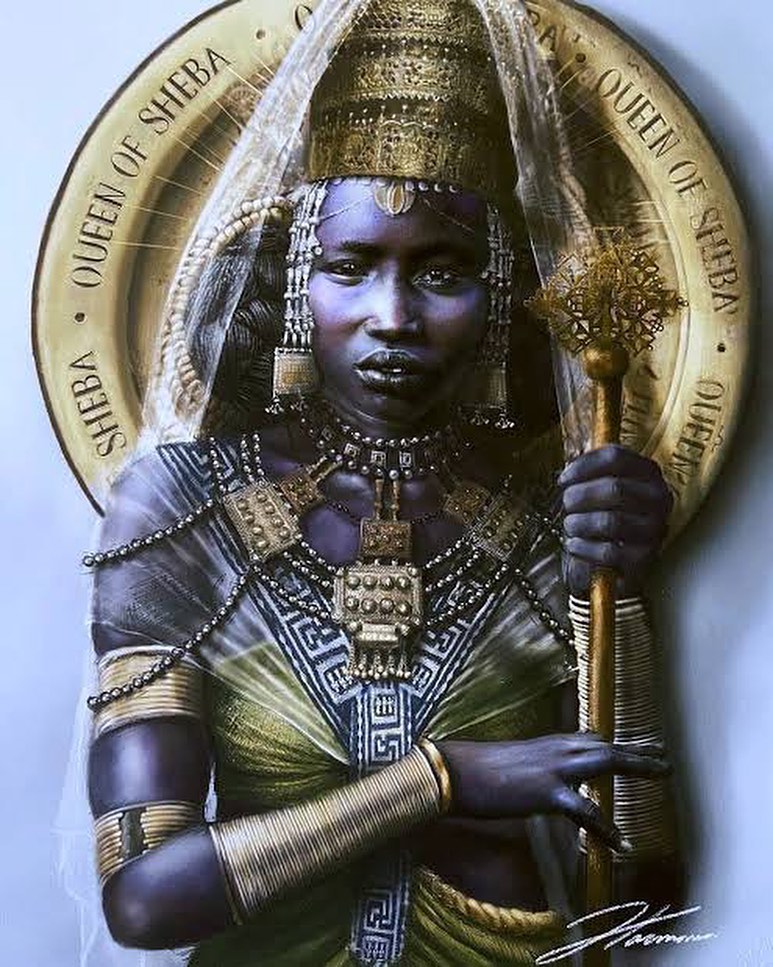Queen of Sheba, known by the Yemeni Arabs as Bilkis, and by the Yorubas as Bilikisu Sungbo Alagawura in the tenth century. The queen, who arrived to see King Solomon after learning of his exceptional wisdom, was portrayed in the Christian Bible as a woman of great strength, intelligence, and insight. She arrived with “a very great caravan of camels, carrying spices, large quantities of gold, and precious stones,” according to the account. Additionally, it was said that “so many spices were brought into Israel never again as those King Solomon received from the Queen of Sheba.” In Islamic tradition, the Arabs, who think she sprang from the Yemeni city of Sheba, also known as Mareb, call her Bilkis, Bilqis, Balqis, or Balquis. Numerous connections have been found between the Biblical queen and Bilikisu Sungbo of Ijebu country, according to historical and archaeological research. It is thought that the Queen of Sheba is connected to wealth, eunuchs, and ivory. Ancient West African palaces were known to contain eunuchs, while ivory and gold are known to have been extremely abundant in Nigeria during that period.
According to history, the Ethiopian national epic and founding tale, Kebra Nagast, or “Glory of King,” features a significant appearance by The Queen of Sheba. In accordance with this legend, after learning of Solomon’s wisdom, the Queen of Sheba, also known as Makeda, went to his court. She spent six months studying under him. King Solomon met Sheba out of curiosity after learning of her exceptional beauty. She was a hairy, dark-skinned woman from a different continent. He fooled her into his bed on the final night of her visit, and she fell pregnant. Once back in her homeland, she gave birth to Solomon’s son, Menilek I, who went on to become the great-grandfather of His Imperial Majesty Emperor Haile Selassie I, the man who founded the Rastafari religion.
As a result of his father’s coronation, Menilek I became the first king of Ethiopia and established the royal Solomonic dynasty. He ruled until His Imperial Majesty Emperor Haile Selassie I was overthrown in 1974. After losing her position in Abyssinia (now Ethiopia), East Africa, the ancient Queen of Sheba (Bilikisu Sungbo) moved to Nigeria, West Africa. She journeyed with her entire caravan, wealth, and slaves, constructing a stronghold at Oke Eiri Ijebu Ode.After attempting to establish a dynasty, she eventually passed away and was buried at Oke Eiri, OGUN state. Ijebu-Ode locals have strong, widely held beliefs over who the disputed Bilikisu Sungbo is.Her mausoleum still stands in Eiri Ijebu Ode, Oke. The burial place of the biblical Queen of Sheba is thought to be located in a location tucked away in the thick rain forests of southwest Nigeria. This burial site is part of a larger region that is encircled by the historic Eredo earthwork, and it is thought to be the site of the wealthy Queen who constructed the famous Wall of Sungbo.
The defensive ditch and wall system known as Sungbo’s Eredo wall, or Fortress, is situated southwest of the Yoruba town of Ijebu Ode in Ogun State, southwest Nigeria. Built between 800 and 1000 AD. The old Queen’s resting place lies in the quiet little community of Oke-Eiri, which is near Ijebu Ode in Ogun State. For generations, local pilgrims have traveled there to honor the sleeping legend. Deep in the Nigerian jungle, a group of British scientists collaborated with Patrick Darling, an archaeologist from Bournemouth University, to find the remnants of an ancient kingdom. Dr. Patrick Darling has finished a preliminary survey of the ditch and leftover wall, which are around 100 feet high overall and 70 feet high in certain places. Thousands of visitors visit the queen of Sheba’s tomb every year out of respect.
This area of the Nigerian rainforest is devoid of any vegetation. Tall trees there have intertwined canopy foliage, fallen leaves, and spider webs, creating a gloom that prevents vegetative growth. In Nigeria, the resting location of the biblical and legendary Queen of Sheba (Bilqis), also referred to as Bilikisu Sungbo by the Yoruba people, has become a popular tourist destination and site of worship. Every year, millions of visitors from all over the world come to explore the mystery surrounding the burial that has been transformed into a shrine at Bilikisu Sungbo.
However, ladies and dogs are not allowed to visit the gravesite of Bilikisu Sungbo according to Ijebu tradition. There is a little patch of open land at the shrine that is devoid of grass. It is reported that the ancient queen used this location to be cleaned before being buried, and as a result of her mystical abilities, nothing can ever grow there, not even grass or plants. The shrine of Bilikisu Sungbo was included in the UNESCO World Heritage List’s cultural category in 1995. The Bilikisu Sungbo “grave-shrine” will always be a source of pride for the Ijebu-Ode community.

